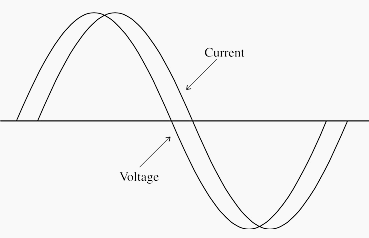Nothing good from harmonics…
The subject of harmonics is also a contributory factor in electrical noise I already wrote few days ago (Cable spacing as a means of noise mitigation). It also causes several other problems in power circuit components such as motors, transformers and capacitor banks.

A load that is purely resistive has the same wave shapes for voltage and current. Both are normally pure sinusoids. Most induction motors fed directly from AC mains also behave in a similar manner except that they draw some reactive load as well. The current waveform is still sinusoidal (see Figure 1).
These devices chop off part of the AC waveform using thyristors or power transistors, which are used as static switches.

Such altered waveforms may be mathematically analyzed using Fourier transforms as a combination of vectors of the power frequency (50/60 Hz) and others whose frequency is a multiple of the power frequency.
The power frequency component is called the fundamental and higher multiples are called harmonics. It should be remembered that all electrical generators produce only voltage at fundamental frequency.
But there has to be a source if a harmonic current has to flow. It is therefore construed theoretically that all harmonic-producing loads are current sources of harmonics. These sources drive harmonic currents through the rest of the system consisting of the source as well as other loads connected to it.
Also, the harmonic currents flowing through the other loads of the system give rise to several abnormalities (refer Table 1 below).
Table 1 – Effects harmonics have on different system components
| Equipment | Effects of harmonics |
| Capacitors | Amplify harmonics on electrical distribution system. |
| Electrical wiring | Phase and neutral conductors undersized. |
| Engine generators | Transferring capability and operation disrupted. |
| Induction motors | May fail prematurely due to fifth harmonic |
| Metering | Inaccurate measurement of power |
| Overcurrent protection | Breaker and fuse nuisance tripping |
| Sensitive electronic loads | Voltage drop between neutral and earth |
| Transformers | Decreased efficiency and overheating |
| Uninterruptible power systems | Line and load interaction |
An example how shunt filters function…
Let us see how these shunt filters function. We can use a computer to show what happens as harmonics are filtered from a distorted wave.

The example chosen is a 120° square wave current with a 10°commutation time; a typical line current waveform for a DC motor drive and for many AC drives. Here is the square wave before any filtering. The distortion factor is 26% not too pretty a waveform (Figure 2a). Now let us take out the fifth harmonic.
This may not look a whole lot better, but the distortion factor is down from 26 to 18%, so things are improving (Figure 2b).
Now let us take out the seventh as well. Things are actually looking better now. We can see the sine wave starting to emerge. Distortion factor is down to 11% (Figure 2c).
Next, we take out the eleventh. Still no beauty queen, but the distortion factor is now only 8% (Figure 2d).
Let us add in the final element and remove the thirteenth harmonic. This is our final current waveform (Figure 2e). The distortion factor is 6%, so we are putting a reasonable current into the utility. Of course, the significance of this current waveform to the voltage distortion would depend on the source impedance and the current level.
Higher-frequency harmonics can be propagated by the power conductors acting as antennae and appear as induced noise voltages in nearby signal circuits.
It is not possible to prevent harmonic currents altogether. But they can be prevented from flowing through the entire system by providing a separate low-impedance path for them. This is done by the use of adequately rated series tuned circuits consisting of a reactor and capacitor, which have equal impedance at a specific harmonic frequency.
Several such tuned banks (one for each harmonic frequency) will be needed to totally divert all harmonics away from the system. However, for practical reasons, only a few of the lower order harmonics with larger magnitudes are filtered out, which is adequate to provide substantial reduction of harmonic content.
Reference: Practical Grounding, Bonding, Shielding and Surge Protection – G. Vijayaraghavan, Mark Brown, Malcolm Barnes (Get hardcopy from Amazon)











We well structured and easy to understand explanation, !!!!
Do metal oxide varistors (MOV’s) have any effect on reducing harmonic distortion?
Hi please tell me why even harmonics cancels each other
Do you have a spam problem on this blog; I also am a blogger, and
I was curious about your situation; many of us have developed some nice procedures and we are looking to exchange methods
with others, why not shoot me an email if
interested.
A nicely presented article.congradulations.
Just another perspective
harmonic presence in a plant electrical system can be catagorised into four groups.
Group 1 : Harmonics do not exist or is negligible. population 10%. No remedial measures warranted.
Group 2 : Harmonics exist with within limits of international standards like IEEE 519 . Population 20% . No remedial measures warranted.
Group 3:Harmonics exists and are above levels of international standards.population-60% However it does not cause any adverse impact on the installation. Remedial measures may be warranted only to comply with statutory requirements or management priorities.Technically there is no need to address the issue
Group 4: Harmonics exist. They are above the levels of international standards. It has impact on the productivity of the installation.population 10% . There is urgent need for remedial measures felt by the installation. The solution often may involve high cost , high risk and technically robust. as its productivity enhancement or cost of energy reduction the installation is willing to invest .
An attempt is made to highlight another aspect of harmonics and the need for remedial measures.
ps: The percentages mentioned are typical rounded figures and will change from country to country.
will like to add that :when harmonics enter the system they can not be eliminated. The filter are like box where you placed them and closed the lid but still there.
Regards
God bless